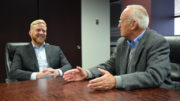BOULDER, CO – In 2009, when the members of Radish Systems, a Boulder-based “Communications as a Service” tech startup, recognized the chance to enhance communication between virtually every member of the US healthcare system, they were ready to make the most of it, because they had done this all before.
“In our first startup, which was called Radish 1.0, we wanted to allow people to share voice and visuals as easily as making a normal telephone call,” Dr. Theresa Szczurek, co-founder and CEO of Radish Systems, told CyberMed News during a recent interview.
Alongside fellow Bell Labs alum Dr. Richard A. Davis, Szczurek founded Radish 1.0 in 1990. (The company’s name is an acronym created by combining the initials of Dr. Davis’s full name with the initials from the phrase “including Szczurek happily.”) Within four years, Microsoft had licensed Radish’s patented technology, which consisted of a modem protocol that allowed data to be transmitted during an ordinary phone call.
“It proliferated and became the de facto standard for voice and visual communications for a number of applications,” Szczurek explained. “One was remote technical support. Another was early e-commerce.”
In 1996, with their technology in use in almost every computer in the world, Szczurek and Davis sold Radish 1.0 for forty million dollars. Then, when smartphones hit the market over a decade later, the two had an epiphany.
“We said, Oh my goodness, this is exactly what we were trying to build back then!’ And that’s when we decided, ‘We have to do it again.”
After convincing the core members of their original team to join the newly formed Radish Systems, Szczurek and Davis spent the next three years rigorously developing ChoiceView, a mobile and web-based app that allows visual information to be shared during phone calls.
With ChoiceView, Szczurek and Davis realized that they had created a technology with the potential to augment communications across every sector of the US economy.
And one of the first industries they set their sights on was healthcare.
A Telemedicine Platform for Everyone
According to Szczurek, ChoiceView’s HIPAA-compliant technology can enrich telephone encounters between patients and providers by allowing them to share visual information with one another.
“If I’m a nurse talking to a patient who has a cut, the patient can easily take a picture of their wound and send it to me. Then, after examining it, I might say, ‘Okay, that’s nothing to worry about, you don’t need to come in.”
While scenarios like this represent a promising means of reducing costly visits to the emergency room, the benefits of ChoiceView extend far beyond improving one-off telemedicine encounters between patients and providers.
Describing the technology as a “pipe,” Szczurek explained that ChoiceView enables healthcare professionals to augment telephone calls with visual aids of virtually any kind. The application allows X-rays, prescription drug information, and patient education materials to be shared, viewed, and discussed during a normal phone conversation. Forms can even be filled out using the app, permitting patients to complete important paperwork prior to their appointments.
Szczurek and Davis envision their technology being implemented throughout the healthcare system, empowering medical professionals of all kinds to rapidly convey complex information. From pharmaceutical companies needing a more efficient way to educate medical professionals about new drugs, to health insurers requiring a means of simplifying the explanation of benefits and billing, the Radish Systems team sees ChoiceView playing a pivotal role.
“A poison control center using this technology would be able to send a caller detailed instructions for dealing with a venomous snake bite or an accidental poisoning, instead of asking the caller to write the instructions down.”
And though smartphone use is at a record high across the nation, ChoiceView has been designed so that it can also be used on a feature phone, a landline, or a conference phone. When a user doesn’t have a smartphone or lacks the ChoiceView app, they are invited to go to a URL on their computer, tablet, or mobile browser, where, after entering their phone number, they will be able to exchange visual information with the caller.
The Market is Ready
As one of the eight startups chosen by Prime Health to compete in its 2015 Digital Health Challenge, Radish Systems had the opportunity to pitch its ChoiceView technology to a large gathering of Colorado healthcare providers.
Among those who agreed to pilot ChoiceView at the Challenge was the Northwest Colorado Visiting Nurse Association.
“We are delighted to investigate improving communication and serving patients faster and with better comprehension,” said Lisa Brown, the association’s CEO, expressing her excitement in a recent press release about the pilot.
Another institution that offered to test ChoiceView was Clinica Tepeyac, a Denver-based healthcare provider dedicated to offering “culturally competent healthcare and preventive health services for the medically underserved.”
“ChoiceView will strengthen customer service on behalf of our patients and the community we serve. This is part of our overall effort to improve communications with our patients and demonstrate responsiveness to their needs,” Jim Garcia, the clinic’s executive director, was quoted as saying in the same release.
Szczurek describes her company’s success at the Digital Health Challenge as the result of over three years of iterating ChoiceView based on market feedback.
At the same time that this period of market testing has allowed Radish Systems to identify its optimal business profile, it has also generated an interest in the ChoiceView technology among potential clients.
“What we’ve learned is that there’s currently a willingness to accept voice and visual communication. The market seems ready for it.”
Like the coverage that CyberMed News provides? Follow us on Twitter, LinkedIn, and Facebook to make sure you keep up to date on the most recent developments in Colorado’s digital health community.






Be the first to comment on "Radish Systems is Enhancing Telemedicine for Healthcare Providers Everywhere"